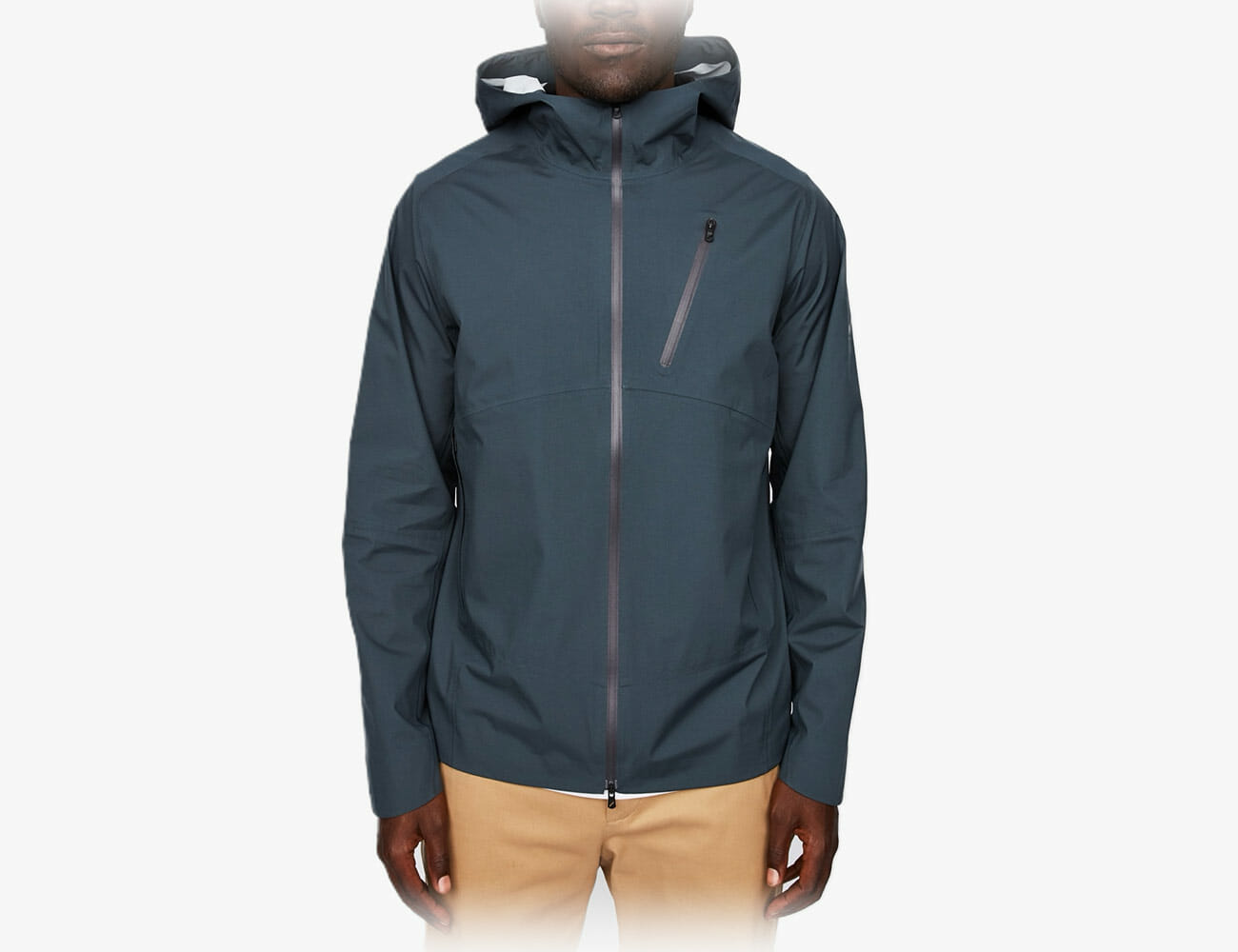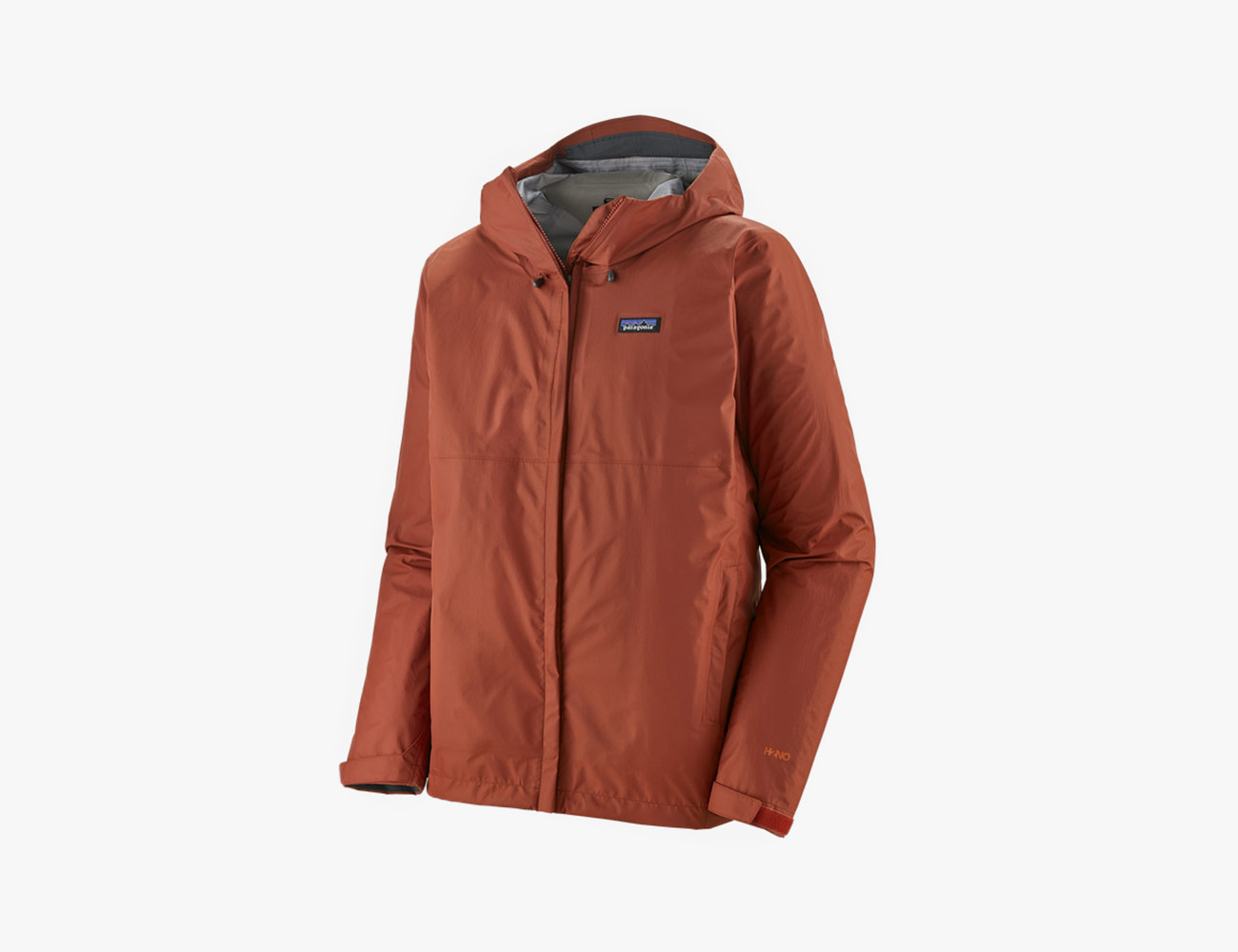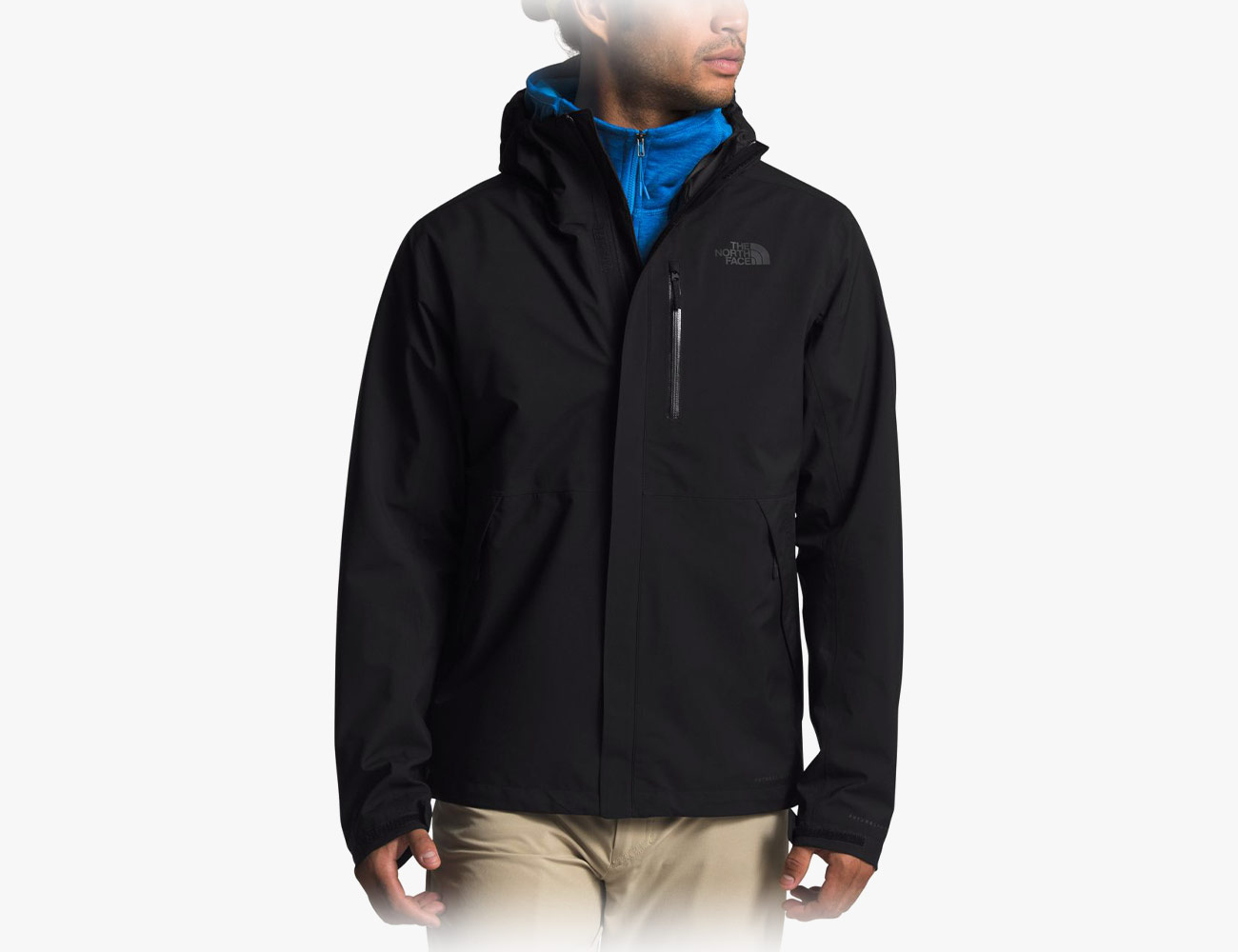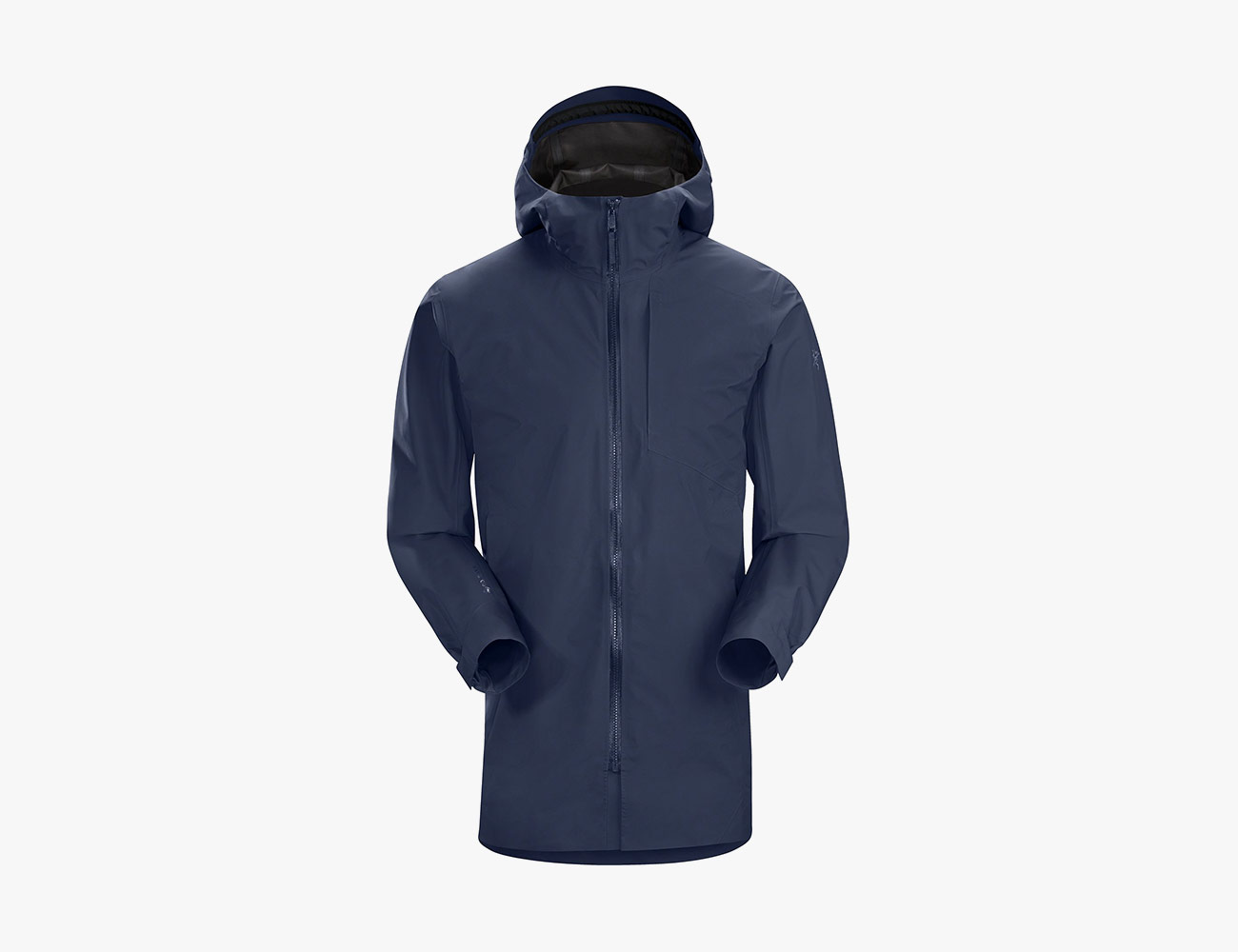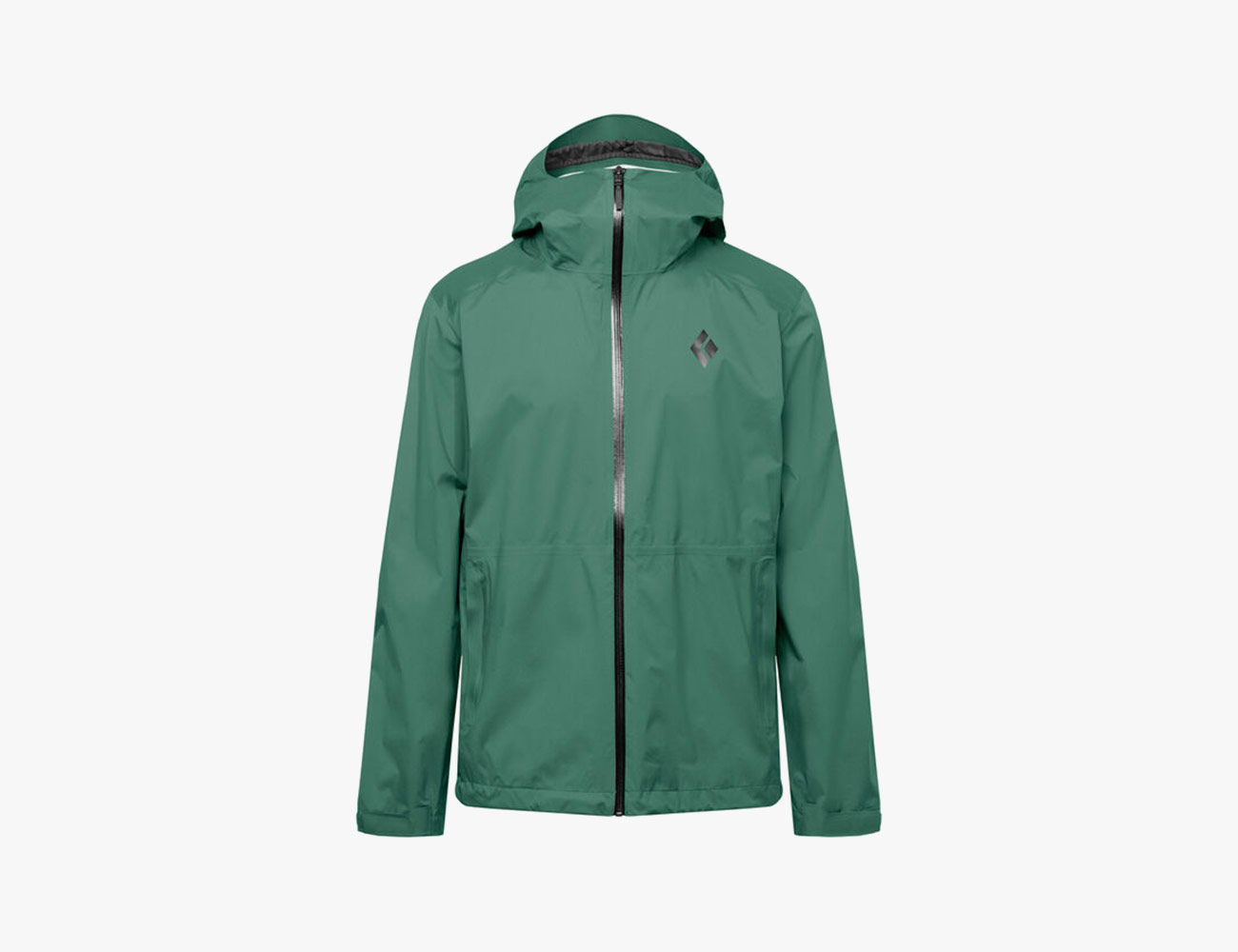Last updated May 2020: New jackets are included for 2020. Prices and links have been updated to reflect current availability.
We live in a Golden Age of water-repellency; before nylon shells and Gore-Tex membranes, humans devised hydrophobic clothing using vinyl, oiled canvas and, before that, cured seal and whale intestines. Now, (thankfully) waterproofing happens at a molecular level with advanced membranes that keep water droplets out but let body vapor (think sweat) through.
The advancements have allowed rain jackets to become lighter, more breathable, packable and no less rain-proof. Rain jacket technology keeps getting better too — today, companies are experimenting with new fabrics to make rain shells softer and more comfortable and adding stretch for increased mobility (and less of that trademark crinkly jacket sound). Style hasn’t fallen by the wayside either. The new class of rain jacket is light enough, durable enough, breathable enough and waterproof enough to handle multi-day treks through misting rain as well as the inevitable deluge during commuting hours.
Rain Jackets 101
Hill City Waterproof Hooded Shell
Editor’s Choice
Hill City, a new men’s brand by Gap that’s sort of the male parallel to Athleta, is off to a flying start. Among the brand’s line of activewear, everyday performance apparel, athleisure — whatever you want to call it — is a high quality technical rain layer. The Hooded Waterproof Shell is straightforward in more ways than just its name, but that’s a good thing. The jacket meets the core requirement of this list, i.e., it’s waterproof — we learned so firsthand during a rainy weekend of hiking in the Adirondack mountains of Upstate New York and in many storms since.
The Hooded Waterproof Shell is more outdoor-oriented than Hill City’s branding might have you think (when it was first released, it was called the Hooded Trail Shell), but it includes some features that make it stand out, even in that performance-oriented crowd. The fit is excellent, the cuffs use snaps instead of Velcro to cinch tighter, there’s a cape-style vent on the back to let in air (but not rain) where it’s most needed, and it’s very lightweight. The only thing some might find it lacks is an adjustable hem, but with all of these other features, we didn’t notice its absence.
Weight: 10 ounces
Membrane/Laminate: 2.5 layer Dermizax 3D membrane
Shell Material: nylon
Patagonia Torrentshell 3L
Best Budget Rain Jacket
A quick Google search for “best rain jacket” will reveal various lists like this one, and Patagonia’s Torrentshell makes an appearance on nearly all of them. It’s the outdoor brand’s jack-of-all-trades rain shell, with a classic construction that includes hand pockets, an adjustable and stowable hood, and zippered underarm vents for when things get warm.
Patagonia made the latest iteration of the Torrentshell with a three-layer construction — the same that you find on ski outerwear — that includes a recycled nylon face fabric, a waterproof membrane and a soft interior lining. It’s an upgrade over the older 2.5-layer model and one that significantly ups the value ante as Patagonia stuck with its already-low $149 price. Patagonia’s Rainshadow rain jacket is similar, but comes at a lower weight and uses a stretchier fabric for $50 more.
Weight: 13.9 ounces
Membrane/Laminate: H2No
Shell Material: 3.3-oz 50-denier Econl 100% recycled nylon ripstop
The North Face Dryzzle FutureLight Jacket
Best Breathable Rain Jacket
When The North Face released its FutureLight waterproof fabric technology in late 2019, it only showed up in outerwear made for skiing, snowboarding and other mountain adventures. Now though, the brand is rapidly rolling the tech into everything from hiking footwear to tents. Like other waterproof membranes, FutureLight is impermeable, but thanks to a unique manufacturing process, it’s also remarkably breathable. That makes it the perfect material for a lightweight rain layer, like the new and improved Dryzzle.
Rain jackets tend to become clammy as soon as temperatures rise, so the additional breathability of FutureLight is a welcome upgrade to this TNF classic. We’ve worn the similar pullover version, the Arque Active Trail FutureLight Jacket ($229), through the New York City subway system, which becomes a sauna in the summertime, and had no sweaty issues.
The Dryzzle is a classic rain jacket with an adjustable hood and hem, an exterior chest pocket and two hand pockets.
Weight: 12 ounces
Membrane/Laminate: FutureLight
Shell Material: 100% recycled polyester
Arc’teryx Sawyer Coat
Best Rain Jacket for Cities
The sleuth detective in an outdoor-themed film noir flick might don the Sawyer. It’s defining characteristic is its clean style, which stems from a logo-less front and a longer sub-hips length. Even the inside is a gunmetal gray instead of the white that’s traditional in most technical rain jackets. It’s not entirely unbranded though, Arc’teryx’s trademark archaeopteryx fossil is perched on the left shoulder, and “Gore-Tex” falls on the right forearm, perhaps the only two visible markers of the tech supporting this jacket.
Drawing on Arc’teryx’s outdoor expertise, the Sawyer is completely waterproof, seam-sealed and lightweight given its length. It’s the perfect rain jacket for those who spend more time in urban environments than in the mountains.
Weight: 13 ounces
Membrane/Laminate: Gore-Tex 3 layer
Shell Material: nylon
Black Diamond Stormline Stretch Rain Shell
Best Stretch Rain Jacket
Stretch is one of the biggest trends in rain jackets at the moment, and it’s easy to write off as a feature only available on jackets at the upper end of the price spectrum. The Black Diamond Stormline Stretch shatters those preconceived notions. It’s impossibly stretchy, still offers 100-percent waterproofing that you’d expect in a high-end rain jacket and comes in at a price of just $149. Bring your lunch to work for a week or two and you’ll have saved up enough for it.
Beyond price, Black Diamond brings some serious performance to the table with its BD.Dry waterproof breathable membrane. It beads water on par with more expensive jackets on this list, and while other features beyond stretch are sparse, you get far more than you pay for.
Weight: 9.9 ounces
Membrane/Laminate: BD.dry
Shell Material: nylon
Mountain Hardwear Exposure/2 Gore-Tex Paclite Plus
Best Rain Jacket for Hiking
Like many of the jackets to make our list this year, Mountain Hardwear’s Exposure/2 Gore-Tex Paclite consists of a fabric that’s not only lightweight but also slightly stretchy. Also superseding older jackets is the Exposure/2’s packability. Mountain Hardwear employed Gore-Tex’s Paclite Plus fabric, which combines these qualities with high durability in a two-layer construction.
The Exposure/2 doesn’t come with underarm vents, but its two oversized hand pockets are lined with mesh on the interior and can be left open to allow heat to escape. The jacket also has an exterior chest pocket and an adjustable hood and hem. At only 9.6 ounces, it’s one of the lighter jackets on this list, and perfect for stashing in a backpack when the forecast isn’t confirmed. That factor, along with its durability, makes the Exposure/2 perfect for the trail.
Note: This is a new jacket for 2020 and will be available by mid-March.
Weight: 9.6 ounces
Membrane/Laminate: Gore-Tex
Shell Material: nylon
Patagonia Storm Racer
Best Rain Jacket for Trail Running
We don’t often reach for rain layers during a run — once our bodies warm up, even a little rain isn’t as uncomfortable as a clammy jacket — but in some scenarios, it’s best not to mess with foul weather. That’s why Patagonia made the Storm Racer, the centerpiece of its trail run-focused High Endurance kit. Built as an emergency layer that packs down small, the Storm Racer is unlike any other running shell.
The hallmark of its design is a dual diagonal zipper system that provides adjustable breathability. One zipper extends to the hem to help you get in and out of the jacket while the other goes just beneath the armpit. Unzip and roll the triangular panel downward to get a little extra breeze on your neck or chest — as well as access to a hydration vest (Patagonia makes one for the High Endurance kit, or you can use your own).
The Storm Racer isn’t an everyday rain layer (its lone pocket — in the hood — is for stuffing and storage). For that reason, if your runs don’t take you down long trails or far from a shelter at all, the Storm Racer might be more jacket than you need (or not enough). Overall though, the zippers and three-layer construction add up to a lightweight last-ditch layer that maximizes weather protection while minimizing annoying jacket flapping.
Weight: 7 ounces
Membrane/Laminate: H2No
Shell Material: 12-denier 100% recycled nylon ripstop
Columbia OutDry EX Reign
Most Innovative Rain Jacket
Compared to other rain jackets, Columbia’s OutDry EX Reign immediately looks different. That’s because OutDry Extreme, one of Columbia’s proprietary waterproofing technologies, is constructed differently than Gore-Tex, Dermizax or other commonly used barriers. Instead of layering the waterproof membrane between a liner and a shell, Columbia put it on the outside, where it’s exposed directly to the weather.
That construction has multiple consequences: the fabric-lined interior wicks and is left soft; the exterior feels more like a classic, slicker-style raincoat that won’t wet out (when a coat’s shell fabric gets saturated). It also means that the seams are taped on the outside, which adds to the jacket’s unique look. It also has two large pockets and underarm zips for venting. The OutDry EX Reign doesn’t follow the most recent trend in rain jackets — it doesn’t have any stretch — but it’s still comfortable, breathes quite well and is impenetrable to rain.
Weight: 22 ounces
Membrane/Laminate: OutDry Extreme
Shell Material: nylon
REI Stormbolt Jacket
Most Durable Rain Jacket
If you’re a serious outdoorsman, it can be easy to dismiss REI’s in-house brand as just that, an in-house brand. But much like Costco’s Kirkland brand, there’s a lot to love. For one, the Stormbolt is incredibly durable. I posit that you could rub it up against a rock face a few too many times and still come away with a jacket that looks and performs as if it were new. It brings a Gore-Tex three-layer construction to the table, which is the gold standard for waterproofing.
The fit allows for layering underneath, which adds to the jacket’s versatility and allows it to be used as a ski shell in winter. If you’re an REI member, there isn’t much of a reason to look elsewhere. Add to your dividend and save for something on your wish list.
Weight: 15 ounces
Membrane/Laminate: Gore-Tex
Shell Material: nylon
Houdini Daybreaker
Best Low-Chance Rain Layer
It’s easy to prep for a forecast that calls for a 100 percent chance of rain. It isn’t always that clear cut, though. Anything below a 50 percent chance becomes something of a toss-up, the result of which leaves us either feeling annoyingly overprepared or sopping at the end of the day. Then there’s drizzle, which might not warrant a full-on rain jacket either. For these days, Houdini’s Daybreaker is the ideal not-a-rain-jacket.
Made of a DWR-treated polyester blend, the Daybreaker is both wind- and water-resistant. It’s also comfortably stretchy, durable, and comes with a UPF 50+ sun protection certification, which makes it perfect for hiking and walking around town. We’ve worn it through heavy drizzle and can attest to its ability to ward off moderate precipitation. It doesn’t have a hood, so think of it like a technical overshirt rather than a rain jacket. (And maybe, depending on how much you trust the weather report, bring your umbrella, just in case).
Weight: 12.8 ounces
Membrane/Laminate: DWR
Shell Material: polyester
Rain Jackets 101
About Rain Jacket Materials
The outer textile of most three-layer shells is made of a rugged nylon or polyester that’s coated with Durable Water Repellent (DWR). The inner membrane is a microporous fabric, typically made of ePTFE or Polyurethane that acts as the shell’s primary waterproof and breathable layer. It’s the secret sauce. The backer textile is a thin layer, usually gauze, that’s laminated to the back of the membrane, which eliminates the need for a liner.
While the waterproof and breathable technologies are all generally related in the way they function, several brands have proprietary technologies, among them Gore-Tex, NeoShell, eVent, Schoeller and Dermizax NX. Discerning one technology from another can be difficult, in part because the technology is kept under lock and key, but also because the technology requires an understanding of terms like “phase change” and how things work on a molecular level. To repair a ripped rain jacket, head here.
DWR Explained
When you’re buying a rain jacket or any outerwear for that matter, you’ll often come across the initials DWR, which stand for durable water repellent. DWR is a coating applied to fabrics that lets them shed fluids, and it’s commonly used in conjunction with waterproof membranes. DWR works by making the surface of the exterior fabric spiky at a microscopic level, which forces water and other liquids into rounder, beaded forms. That helps them roll off the garment instead of saturating it. DWR isn’t permanent, but it can easily be revived. To re-waterproof your rain jacket, head here.



